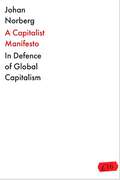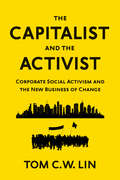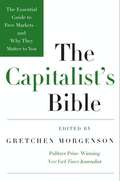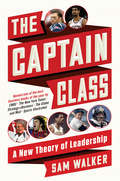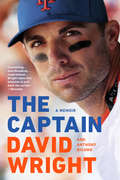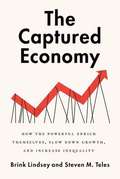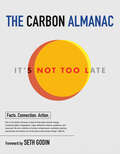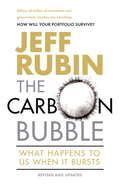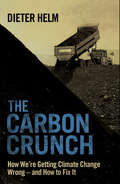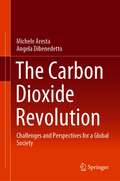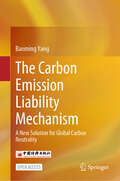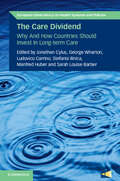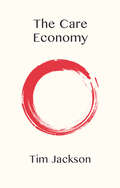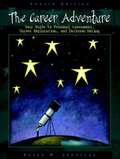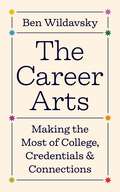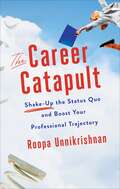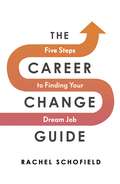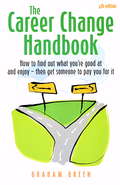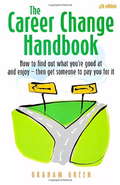- Table View
- List View
The Capitalist Manifesto: Why The Global Free Market Will Save The World
by Johan NorbergMarx and Engels were right when they observed in the Communist Manifesto that free markets had in a short time created greater prosperity and more technological innovation than all previous generations combined. A century and a half later, all the evidence shows that capitalism has lifted millions and millions from hunger and poverty. Today's story about global capitalism, shared by right-wing and left-wing populists, but also by large sections of the political and economic establishment, does not deny that prosperity has been created, but it says it ended up in far too few hands. This in turn has made it popular to talk about the global economy as a geopolitical zero-sum game, where we have to fight to control new innovations, introduce trade barriers and renationalize value chains. While, more broadly, capitalism is accused of fueling glaring inequality, populist revolts, climate change and China's global conquest. In this incisive and passionate investigation, Johan Norberg instead states the case for capitalism and the vital role played by the free market in today's uncertain world. Ultimately, he argues that that a move away from global capitalism would not only squeeze the growth out of the economy but also deepen an already large social exclusion for the vulnerable - for the world's poor, it would be a killing blow.
The Capitalist Personality: Face-to-Face Sociality and Economic Change in the Post-Communist World (Routledge Advances in Sociology #86)
by Christopher S. SwaderModern capitalism favors values that undermine our face-to-face bonds with friends and family members. Focusing on the post-communist world, and comparing it to more "developed" societies, this book reveals the mixed effects of capitalist culture on interpersonal relationships. While most observers blame the egoism and asocial behavior found in new free-market societies on their communist pasts, this work shows how relationships are also threatened by the profit orientations and personal ambition unleashed by economic development. Successful people in societies as diverse as China, Russia, and Eastern Germany adjust to the market economy at a social cost, relaxing their morals in order to obtain success and succumbing to increased material temptations to exploit relationships for their own financial and professional gain. The capitalist personality is internally troubled as a result of this "sellout," but these qualms subside as it devalues intimate qualitative bonds with others. This book also shows that post-communists are similarly individualized as people living in Western societies. Capitalism may indeed favor values of independence, creativity, and self-expressiveness, but it also rewards self-centeredness, consumerism, and the stripping down of morality. As is the case in the West, capitalist culture fosters an internally conflicted and self-centered personality in post-communist societies.
The Capitalist and the Activist: Corporate Social Activism and the New Business of Change
by Tom C. Lin2023 Axiom Business Books Award Silver Medalist (Business Commentary)2023 Nautilus Book Award Silver Medalist (Social Change & Social Justice)This is the first in-depth examination of the important ongoing fusion of activism, capitalism, and social change masterfully told through a compelling narrative filled with vivid stories and striking studies.Corporations and their executives are at the forefront of some of the most contentious and important social issues of our time. Through pronouncements, policies, boycotts, sponsorships, lobbying, and fundraising, corporations are actively engaged in issues like immigration reform, gun regulation, racial justice, gender equality, and religious freedom. Despite corporate social activism being everywhere these days-witness how quickly companies and progressives united to oppose North Carolina's bathroom bill or support the Black Lives Matter movement-there has been no in-depth examination of the far-reaching consequences of this movement. What first principles should guide businesses' approaches? How should activists engage with businesses in a way that is most beneficial to their causes? What are potential pitfalls and risks associated with corporate social activism for activists, businesses, and society at large? Weaving studies and stories, Temple University professor of law, Tom C. W. Lin offers a road map for how we got here and a compass for where we are going as a nation of capitalists and activists seeking profit and progress.
The Capitalist's Bible
by Gretchen MorgensonEverything you ever wanted-and needed-to know about capitalism . . . but were afraid to ask. What is capitalism, and will it survive? What does globalization really mean-and how does it affect your bank account? If capitalism, left unchecked, has caused disasters like the Great Depression and the financial crisis of 2008-09, why has it been the economic system of choice for centuries? To many people, the complex, jargon-rich world of capitalism can be intimidating, raising more questions than it answers. However, as the excesses and failures of free-market capitalism continue to hold sway over the daily news and our daily lives, understanding our economic system-including where it has succeeded and where it has not-is more important than ever. Edited by New York Times business journalist Gretchen Morgenson, The Capitalist's Bible is the essential reference on capitalism and how it works-from the people who champion it to the mechanisms and institutions that uphold it to the terms and laws that define it. Whether you seek a more well-rounded understanding of the ideology that underwrites America's-and, increasingly, the world's-economy, or simply wish to be able to speak more knowledgeably on the subject in conversation, this book is an invaluable tool for understanding capitalism.
The Captain Class: A New Theory of Leadership
by Sam WalkerThe founding editor of The Wall Street Journal’s sports section profiles the greatest teams in history and identifies the counterintuitive leadership qualities of the unconventional men and women who drove them to succeed.The secret to winning is not what you think it is. It’s not the coach. It’s not the star. It’s not money. It’s not a strategy. It’s something else entirely. Several years ago, Sam Walker set out to answer one of the most hotly debated questions in sports: What are the greatest teams of all time? He devised a formula, then applied it to thousands of teams from leagues all over the world, from the NBA to the English Premier League to Olympic field hockey. When he was done, he had a list of the sixteen most dominant teams in history. At that point, he became obsessed with another, more complicated question: What did these freak teams have in common? As Walker dug into their stories, a pattern emerged: Each team had the same type of captain—a singular leader with an unconventional skill set who drove it to achieve sustained, historic greatness. Fueled by a lifetime of sports spectating, twenty years of reporting, and a decade of painstaking research, The Captain Class tells the surprising story of what makes teams exceptional. Drawing on original interviews with athletes from two dozen countries, as well as general managers, coaches, executives, and others skilled at building teams, Walker identifies the seven core qualities of this Captain Class—from extreme doggedness and emotional control to a knack for nonverbal communication to tactical aggression and the courage to stand apart. Told through riveting accounts of some of the most pressure-soaked moments in sports history—from Bill Russell’s legendary “Coleman Play” in the 1957 NBA Finals to Barcelona’s “Figo Game” against Real Madrid in 2000—The Captain Class doesn’t just bring these events to life; it presents a fresh, counterintuitive take on leadership that can be applied to a wide spectrum of competitive disciplines. The men and women who make up the Captain Class were never the most skilled athletes, nor were they gifted orators or paragons of sportsmanship. They were often role players who were allergic to the spotlight. In short, the seven attributes they shared challenge your assumptions of what inspired leadership looks like.Advance praise for The Captain Class“Well-researched, wildly entertaining, and thought-provoking. In The Captain Class, Sam Walker presents compelling narratives about the secret ingredient to the greatest teams of all time—and quickly makes you reexamine long-held beliefs about leadership and the glue that binds winning teams together.”—Theo Epstein, President of Baseball Operations for the Chicago Cubs“In The Captain Class, Sam Walker gives us important and original insights into the mysterious ingredients of transformative leadership. A stunning mix of research and narrative.”—Susan Cain, bestselling author of Quiet “If you care about leadership, talent development, or the art of competition, you need to read this immediately.”—Daniel Coyle, bestselling author of The Talent Code“The Captain Class is a brilliant hybrid: one-part detective story and one-part leadership book, set in the world of sports, and dedicated to a fascinating mystery: What sets apart the greatest teams of all time? I’m not even a sports nut and I couldn't put it down.”—Dan Heath, co-author of the New York Times bestseller Made to Stick
The Captain: A Memoir
by David Wright Anthony DiComoThe memoir from the last Mets captain, David Wright, one of the most admired players in recent MLB history, about his inspiring and deep commitment to the game. David Wright played his entire fourteen-year Major League Baseball career for the New York Mets. And when he came back time and again from injury, he demonstrated the power of hard work, commitment, and love of the game. Wright was nicknamed "Captain America" after his performance in the 2013 World Baseball Classic. He is a seven-time All-Star, a two-time Gold Glove Award winner, a two-time Silver Slugger Award winner, and a member of the 30-30 club. He holds Mets franchise records for most career RBIs, doubles, total bases, runs scored, walks, sacrifice flies, times on base, extra base hits, strikeouts, double plays, and hits. He was named captain of the Mets in 2013, becoming the fourth captain in the team's history. Now the widely admired, beloved New York Mets third baseman and captain tells it from his perspective.
The Captured Economy: How The Powerful Become Richer, Slow Down Growth, And Increase Inequality
by Brink Lindsey Steven TelesFor years, America has been plagued by slow economic growth and increasing inequality. In The Captured Economy, Brink Lindsey and Steven M. Teles identify a common factor behind these twin ills: breakdowns in democratic governance that allow wealthy special interests to capture the policymaking process for their own benefit. They document the proliferation of regressive regulations that redistribute wealth and income up the economic scale while stifling entrepreneurship and innovation. They also detail the most important cases of regulatory barriers that have worked to shield the powerful from the rigors of competition, thereby inflating their incomes: subsidies for the financial sector's excessive risk taking, overprotection of copyrights and patents, favoritism toward incumbent businesses through occupational licensing schemes, and the NIMBY-led escalation of land use controls that drive up rents for everyone else. An original and counterintuitive interpretation of the forces driving inequality and stagnation, The Captured Economy will be necessary reading for anyone concerned about America's mounting economic problems and how to improve the social tensions they are sparking.
The Carbon Almanac: It's Not Too Late
by The Carbon Almanac NetworkWhen it comes to the climate, we don&’t need more marketing or anxiety. We need established facts and a plan for collective action.The climate is the fundamental issue of our time, and now we face a critical decision. Whether to be optimistic or fatalistic, whether to profess skepticism or to take action. Yet it seems we can barely agree on what is really going on, let alone what needs to be done. We urgently need facts, not opinions. Insights, not statistics. And a shift from thinking about climate change as a &“me&” problem to a &“we&” problem. The Carbon Almanac is a once-in-a-lifetime collaboration between hundreds of writers, researchers, thinkers, and illustrators that focuses on what we know, what has come before, and what might happen next. Drawing on over 1,000 data points, the book uses cartoons, quotes, illustrations, tables, histories, and articles to lay out carbon&’s impact on our food system, ocean acidity, agriculture, energy, biodiversity, extreme weather events, the economy, human health, and best and worst-case scenarios. Visually engaging and built to share, The Carbon Almanac is the definitive source for facts and the basis for a global movement to fight climate change. This isn&’t what the oil companies, marketers, activists, or politicians want you to believe. This is what&’s really happening, right now. Our planet is in trouble, and no one concerned group, corporation, country, or hemisphere can address this on its own. Self-interest only increases the problem. We are in this together. And it&’s not too late for concerted, collective action for change.
The Carbon Bubble
by Jeff RubinFor the first time at book length, bestselling author and economist Jeff Rubin addresses Canada's national economic future--and the financial security of all Canadians. Since 2006 and the election of the 1st Harper government, the vision of Canada's future as an energy superpower has driven the political agenda, as well as the fast-paced development of Alberta's oil sands and the push for more pipelines across the country to bring that bitumen to market. Anyone who objects is labeled a dreamer, or worse--an environmentalist: someone who puts the health of the planet ahead of the economic survival of their neighbours. In The Carbon Bubble, Jeff Rubin compellingly shows how Harper's economic vision for the country is dead wrong. Changes in energy markets in the US--where domestic production is booming while demand for oil is shrinking--are quickly turning Harper's dream into an economic nightmare. The same trade and investment ties to oil that pushed the Canadian dollar to record highs are now pulling it down, and the Toronto Stock Exchange, one of the most carbon-intensive stock indexes in the world--with over 25 percent market capitalization in oil and gas alone--will be increasingly exposed to the rest of the world's efforts to reduce carbon emissions. Rubin argues that there is a lifeline to a better future. The very climate change that will leave much of the country's carbon unburnable could at the same time make some of Canada's other resource assets more valuable: our water and our land. In tomorrow's economy, he argues, Canada won't be an energy superpower, but it has the makings of one of the world's great breadbaskets. And in the global climate that the world's carbon emissions are inexorably creating, food will soon be a lot more valuable than oil.
The Carbon Crunch: How We're Getting Climate Change Wrong—and How to Fix It
by Dieter HelmAn economist&’s take on &“why the world&’s efforts to curb the carbon dioxide emissions behind global warming have gone so wrong, and how it can do better&” (Financial Times). Despite commitments to renewable energy and two decades of international negotiations, global emissions continue to rise. Coal, the most damaging of all fossil fuels, has actually risen from 25% to almost 30% of world energy use. And while European countries congratulate themselves on reducing emissions, they&’ve increased their carbon imports from China and other developing nations, who continue to expand their coal use. As standards of living improve in developing countries, coal use can only increase as well—and global temperatures along with it. Written by an Oxford economist who specializes in environmental issues, this book goes beyond pieties and pipe dreams to address the practical realities that are preventing us from making progress on this crucial issue—and what we can do differently before it&’s too late. &“Should be compulsory reading for the entire political class as well as the bureaucratic elite and the commentariat.&”—New Statesman &“An optimistically levelheaded book about actually dealing with global warming.&”—Kirkus Reviews (starred review) &“A powerful and heartfelt plea for hard-nosed realism.&”—New Scientist
The Carbon Dioxide Revolution: Challenges and Perspectives for a Global Society
by Michele Aresta Angela DibenedettoThis book focuses on carbon dioxide and its global role in our everyday life. Starting with society's dependency on energy, it demonstrates the various sources of carbon dioxide and discusses the putative effects of its accumulation in the atmosphere and its impact on the climate. It then provides an overview of how we can reduce carbon dioxide production and reviews innovative technologies and alternative energy resources. The book closes with a perspective on how carbon dioxide can be utilized reasonably and how mimicking nature can provide us with a solution. Using simple language, this book discusses one of today's biggest challenges for the future of our planet in a way that is understandable for the general public. The authors also provide deep insights into specific issues, making the book a useful resource for researchers and students.
The Carbon Emission Liability Mechanism: A New Solution for Global Carbon Neutrality
by Baoming YangThis open access book presents a novel Carbon Emission Liability Mechanism (CELM) and an integrated global Carbon Pricing Mechanism, based on a comprehensive analysis of the evolution of economic theory related to global climate change and the practice of carbon pricing instruments over the past 30 years. It further outlines a top-level design and implementation blueprint global based on CELM to achieve global carbon neutrality.For the first time, the CELM mechanism effectively addresses the three fundamental questions regarding carbon emissions: who should be liable for carbon emission, how much liability, and how to offset it. The introduction of CELM may unveil a feasible third path towards global carbon neutrality, and effectively address numerous challenges of carbon tax and Emission Trading System.CELM facilitates the creation of an efficient, cost-effective and comprehensive societal carbon footprint database, and addresses issues related to international carbon border regulation mechanism. While the world is struggling to tackcle the imminent climate crisis, CELM offers a refreshing global carbon neutrality solution, with its characteristics of more fair, more efficient, and less expensive, bringing new alternative options for the international community.
The Carbon Market
by Andre F. Perold Forest Reinhardt Mikell HymanThe carbon market has emerged in response to concerns about global climate change. This note characterizes the market in 2008, describing each segment and how it operates.
The Care Delivery Value Chain: Operationalizing Value-Based Health Care Delivery
by Michael E. Porter Elizabeth Olmsted TeisbergValue-based competition requires a transformation of health care delivery. To help make the ideas of value-based competition concrete and operational, the authors introduce the care delivery value chain (CDVC). The CDVC offers a systematic framework to delineate and analyze the process of care delivery for a medical condition. It is constructed for a medical condition, not for an individual procedure or intervention. Examples covering different types of medical conditions are provided.
The Care Dividend: Why and How Countries Should Invest in Long-Term Care (European Observatory on Health Systems and Policies)
by Ludovico Carrino Jonathan Cylus George Wharton Stefania Illinica Manfred Huber Sarah Louise BarberLong-term care often falls by the wayside in national policy dialogues. As populations age around the world and the prevalence of chronic conditions increases, greater numbers of people will need care and support, putting added pressures on acute-care facilities, communities, and families, among others. This increase in demand for long-term care raises questions about the capacity of governments to provide access to needed care, how these services will be properly resourced and who should receive these benefits. The Care Dividend provides a roadmap for investing in long-term care systems. It argues for increased public investment in high-quality, universally accessible long-term care and explains why these systems benefit everyone: households, health systems, economies, and societies. Bringing together a team of academics and policy experts from around the world, this book explains why and how governments can, and should, take action. This title is also available as Open Access on Cambridge Core.
The Care Economy
by Tim JacksonCare is the foundation of organic life. But its fate in the economy is precarious and uncertain. The labour of care is arduous and underpaid. Yet without it health and vitality are impossible. Care itself ends up leading a curious dual life. In our hearts it’s honoured as an irreducible good. But in the market it’s treated as a second class citizen – barely recognised in the relentless rush for productivity and wealth.How did we arrive in this dysfunctional place? And what can we do to change things? What would it mean to take health seriously as a societal goal? What would it take to adopt care as an organising principle in the economy? Renowned ecological economist Tim Jackson sets out to tackle these questions in this timely and deeply personal book. His journey travels through the history of medicine, the economics of capitalism and the philosophical underpinnings of health. He unpacks the gender politics of care, revisits the birthplace of a universal dream and confronts the demons that prevent us from realising it. Irreverent, insightful and profoundly inquisitive, The Care Economy offers a bold and accessible manifesto for a healthier and more humane society.
The Care and Feeding of the Alpha Male: Achieving High-Level Health and Wellness
by Kate Ludeman Eddie ErlandsonThe excesses of all four alpha male types wreak havoc not only on coworkers but on the alphas' own brains and vital organs. This chapter describes processes for managing the risk of alpha breakdown or defective leadership, from detecting the symptoms of living in the hot-reacting, hyper-adrenaline fast lane, to building a repertoire of anti-stress tools.
The Career Adventure: Your Guide to Personal Assessment, Career Exploration, and Decision Making (4th edition)
by Susan M. Johnston<p>Focused solidly on “doing” rather than on “explaining,” this book gets right to the heart of career decision making it will: <p> <li>walk you through the process of self-knowledge and self-discovery, <li>encourage you to believe in yourself and in your own ability to influence outcomes and achieve career goals, and <li>guide you in working with various job/career-search and development tools</li> <p> <p>This edition offers expanded use of electronic and internet resources, an update of Maslow’s Hierarchy, and a new perspective on decision-making, as well as covers the topics of self-assessment, exploring the world of work, and organizing the job search. Comprehensive appendices offer sample resumes and cover letters, as well as other job search resources. An excellent and valuable guide for all those involved in a job search or a career change.</p>
The Career Arts: Making the Most of College, Credentials, and Connections
by Ben WildavskyA persuasive case for building career success through broad education, targeted skills, and social capitalYoung people coming out of high school today can expect to hold many jobs over the course of their lives, which is why they need a range of essential skills. The Career Arts provides a corrective to the widespread and misleading notion that there is a direct trade-off between going to college and acquiring practical job skills. Ben Wildavsky cuts through the noise and anxiety surrounding this issue to offer sensible, clear-eyed guidance for anyone who is making decisions about education and career preparation with a view to getting ahead in the workforce.Drawing on evidence-based research, illuminating case studies, and in-depth interviews, Wildavsky shares the most vital lessons of what he calls the career arts, which include cultivating a mix of broad and targeted skills, taking advantage of employer-funded education benefits, and preparing for the world as it is, not as you wish it could be. He explains why college remains the gold standard of credentials, and presents the most promising high-quality supplements and alternatives to college that can help learners combine general and job-specific skills. He shows how building social capital is also critical to success, particularly for disadvantaged students.An invaluable guidebook for students, parents, counselors, and educators, The Career Arts reveals why college education and job preparation are not either-or propositions and identifies the blend of education and networking needed to support real-world career aspirations.
The Career Catapult: Shake-Up the Status Quo and Boost Your Professional Trajectory
by Roopa UnnikrishnanTake charge of your career and leap confidently into your future: “Intriguing, insightful, useful, and very readable.” —Jon R. Katzenbach, bestselling author of The Wisdom of TeamsWhen change is a constant and the nature of work rapidly evolves, it’s easy to become fearful and discouraged. In The Career Catapult, innovative career consultant Roopa Unnikrishnan shows you how to gaze into an uncertain future and shape it to your advantage—regardless of your current position in the job hierarchy.Leaping into a revised career trajectory requires quick and purposeful movement. Roopa offers five essential disciplines that will catapult you along the fast track:Dig Deep to Soar: Examine your skills and resources to accurately assess your marketplace valueStalk Innovations and Trends: Explore the context in which you can offer your valueJolt Your Network: Use your assets, including networks that can drive significant valuePrototype Possibilities: Free yourself to imagine—visualize the full array of possibilities and test-drive themGo Extreme: Recognize opportunity when your desired future is within reach—and reach for itDisruption isn’t just for tech moguls. When you dare to change the status quo and bring an innovative spirit to your own career, the sky becomes the limit!
The Career Change Guide: Five Steps to Finding Your Dream Job
by Rachel SchofieldDiscover what you really want from work - and how to get there - with this empowering, practical guide from expert career coach Rachel SchofieldAS SEEN IN GOOD HOUSEKEEPINGONE OF THE TELEGRAPH'S BEST SELF-HELP BOOKS OF 2023'A doable plan to make changes that'll stick. This is the only book you need to take the leap' STYLISTAre you dreaming of a new career? Or do you just want more out of your job? Either way, The Career Change Guide ensures that work works for you . . .__________This empowering, practical guide takes the confusion, fear and indecision out of career change.Whether making small adjustments or life-changing moves, it provides simple, achievable steps to turn your dreams into reality.The Career Change Guide will help you investigate your skills as well as discover your drives, interests and inspirations. It will take you on a structured five step journey. . .· Preparing · Reflecting · Imagining & Designing · Taking Action · Keeping Going ·. . . to lead you to the job of your dreams.You'll learn to . . .- Be clear about who you are and the work and life you want- Devise and explore career ideas- Tackle self-doubt and build confidence- Design an action plan for changeThe Career Change Guide is your first step to a better career and a happier life.So enough procrastination. . . are we doing this, or aren't we?
The Career Change Handbook (4th Edition): How To Find Out What You're Good At And Enjoy - Then Get Someone To Pay You For It
by Graham GreenA successful career move involves people matching their ideas, passions and goals to the needs of employers and vice versa. Full of practical examples of what works and what doesn't in the world of work, this book explains what employers need and how you can place yourself to deliver it. Whether you are looking for a new career or want to move to a different job, here you will find out how to know yourself, identify what you have to sell, structure your job search, target your CV, network successfully, respond to advertisements, conduct interviews and get the best out of agencies. Plenty of sample letters and CVs, exercises and useful addresses will make sure that your next career move is a move in the right direction.
The Career Change Handbook 4th Edition: How to Find Out What You're Good at and Enjoy - Then Get Someone to Pay You for it
by Graham GreenA successful career move involves people matching their ideas, passions and goals to the needs of employers and vice versa. Full of practical examples of what works and what doesn't in the world of work, this book explains what employers need and how you can place yourself to deliver it. Whether you are looking for a new career or want to move to a different job, here you will find out how to know yourself, identify what you have to sell, structure your job search, target your CV, network successfully, respond to advertisements, conduct interviews and get the best out of agencies. Plenty of sample letters and CVs, exercises and useful addresses will make sure that your next career move is a move in the right direction.Contents: Acknowledgements; Preface to the fourth edition; Introduction; 1. What do you really want to do?; 2. Your main marketing tool; 3. The best way - networking; 4. The next best way; 5. Helping others to help you; 6. Meeting of minds; 7. The negotiation game; 8. In the new position; Appendices; Bibliography; Useful addresses; Index.
The Career Change Handbook 4th Edition: How to Find Out What You're Good at and Enjoy - Then Get Someone to Pay You for it
by Graham GreenA successful career move involves people matching their ideas, passions and goals to the needs of employers and vice versa. Full of practical examples of what works and what doesn't in the world of work, this book explains what employers need and how you can place yourself to deliver it. Whether you are looking for a new career or want to move to a different job, here you will find out how to know yourself, identify what you have to sell, structure your job search, target your CV, network successfully, respond to advertisements, conduct interviews and get the best out of agencies. Plenty of sample letters and CVs, exercises and useful addresses will make sure that your next career move is a move in the right direction.Contents: Acknowledgements; Preface to the fourth edition; Introduction; 1. What do you really want to do?; 2. Your main marketing tool; 3. The best way - networking; 4. The next best way; 5. Helping others to help you; 6. Meeting of minds; 7. The negotiation game; 8. In the new position; Appendices; Bibliography; Useful addresses; Index.
The Career Change Handbook 4th Edition: How to find out what you're good at and enjoy - then get someone to pay you for it
by Graham GreenA successful career move involves people matching their ideas, passions and goals to the needs of employers and vice versa. Full of practical examples of what works and what doesn't in the world of work, this book explains what employers need and how you can place yourself to deliver it. Whether you are looking for a new career or want to move to a different job, here you will find out how to know yourself, identify what you have to sell, structure your job search, target your CV, network successfully, respond to advertisements, conduct interviews and get the best out of agencies. Plenty of sample letters and CVs, exercises and useful addresses will make sure that your next career move is a move in the right direction.
